Our AP US Government unit 4 practice test includes 25 more multiple choice questions. This unit considers political socialization and how attitudes about government and politics in America are developed. It also looks at policy-making with an emphasis on economic and social policy. Measuring and evaluating public opinion and ideology of political parties are also covered.
Congratulations - you have completed .
You scored %%SCORE%% out of %%TOTAL%%.
Your performance has been rated as %%RATING%%
Your answers are highlighted below.
Question 1 |
Which of the following is the primary agent of political socialization?
Family | |
Gender | |
Race | |
Religion |
Question 1 Explanation:
The correct answer is (A). While all four options are agents of political socialization, the family has the greatest influence an individual’s political beliefs. More often than not, people take on the political beliefs of their parents.
Question 2 |
Why are both Democrats and Republicans generally reluctant to decrease spending on Social Security?
Social Security payments are guaranteed by laws that cannot be changed | |
Most Social Security benefits are paid to older people, and older people are more likely to vote | |
The Social Security trust fund is so large that it is unlikely to run out of money in the next century | |
Democrats and Republicans have worked out their differences by partially privatizing Social Security |
Question 2 Explanation:
The correct answer is (B). Congressmen need to win re-election, so cutting benefits to active voters is dangerous.
Social Security payments are guaranteed by laws, but laws can be changed. Therefore, answer (A) is incorrect. It is a well-known fact that the Social Security trust fund is running out of money, so answer (C) is wrong. Social Security has not been privatized, so answer (D) is wrong.
Social Security payments are guaranteed by laws, but laws can be changed. Therefore, answer (A) is incorrect. It is a well-known fact that the Social Security trust fund is running out of money, so answer (C) is wrong. Social Security has not been privatized, so answer (D) is wrong.
Question 3 |
Questions 3–4 refer to the map below:
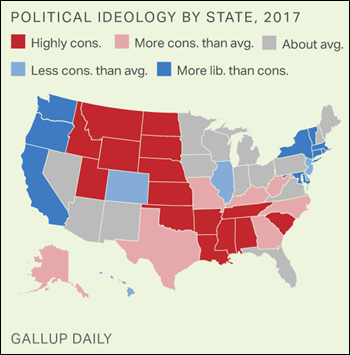
Based on the map, which of the following statements is true?
The West Coast states vote Republican | |
The Deep South states vote Democratic | |
The majority of the Great Lakes states vote for either party | |
Most states along the Mexican border are politically neutral |
Question 3 Explanation:
The correct answer is (C). The Great Lakes states are gray, so they are “swing” states, voting for Democrats in some elections and Republicans in others.
The West Coast states (A) are very blue, which means they vote Democratic. The Deep South states (B) are very red, which means they vote Republican. Half the states along the Mexican border (D) are not neutral, as California votes Democratic and Texas votes Republican.
The West Coast states (A) are very blue, which means they vote Democratic. The Deep South states (B) are very red, which means they vote Republican. Half the states along the Mexican border (D) are not neutral, as California votes Democratic and Texas votes Republican.
Question 4 |

Which of the following does NOT contribute to the political leanings in the Deep South?
Deep South states have large populations of Evangelical Christians | |
Deep South states support a strong national government | |
Deep South states tend to have low rates of taxation | |
Deep South states are right-to-work states |
Question 4 Explanation:
The correct answer is (B). Deep South states traditionally support states’ rights. Deep South states are right-to-work states with large percentages of Evangelical Protestants and lower rates of taxation, especially on income and property.
Question 5 |
Questions 5–6 refer to the chart below:
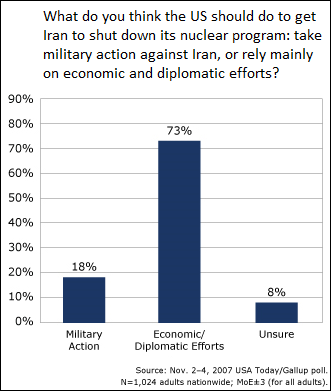
Which of the following is a weakness in the data shown above?
The poll was not a random sample | |
The poll only surveyed 1,024 adults | |
The poll should not have “unsure” as an option | |
The poll assumes that respondents have adequate knowledge of United States foreign policy |
Question 5 Explanation:
The correct answer is (D). Most Americans have very little knowledge of foreign policy, but 91 percent of respondents still expressed an opinion.
There is no way of knowing if the poll did or did not use a random sample, so answer (A) may be eliminated. A poll of 1,024 adults is enough to have statistically reliable data, so answer (B) may also be eliminated. Polls should always have an unsure option, so answer (C) is also incorrect.
There is no way of knowing if the poll did or did not use a random sample, so answer (A) may be eliminated. A poll of 1,024 adults is enough to have statistically reliable data, so answer (B) may also be eliminated. Polls should always have an unsure option, so answer (C) is also incorrect.
Question 6 |

Which of the following would be the best way to improve the quality of the data?
The poll should use a larger sample size | |
The poll should only survey likely voters | |
The poll should disaggregate the data based on male and female responses | |
The poll should provide more than two options along with a Likert scale |
Question 6 Explanation:
The correct answer is (D). The poll itself is flawed because it only provides two substantive options. A Likert scale would measure the extent to which respondents agree or disagree with each of the proposed actions, which would improve the poll’s accuracy.
The sample size of 1,024 is adequate, so answer (A) may be eliminated. Surveying only likely voters (B) or disaggregating that data (C) would be interesting but would not produce better data.
The sample size of 1,024 is adequate, so answer (A) may be eliminated. Surveying only likely voters (B) or disaggregating that data (C) would be interesting but would not produce better data.
Question 7 |
By when did the Democratic and Republican parties emerge as the two dominant political parties?
1860s | |
1900s | |
1950s | |
1980s |
Question 7 Explanation:
The correct answer is (A). Since the 1860 presidential election, each president has been a member of the Democratic or Republican party.
Question 8 |
Family, religious institutions and traditions, peer groups, education systems, and the media are referred to as
Political motivators | |
Opinion leaders | |
Agents of socialization | |
Opinion motivators |
Question 8 Explanation:
The correct answer is (C). Each of the examples listed in the question influence political socialization.
Question 9 |
Questions 9–10 refer to the graph below:
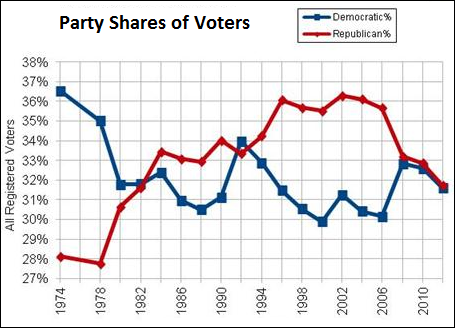
According to the graph, which of the following statements is true?
Democrats won the presidential elections of 1976, 1980, and 1992 | |
Republicans won the presidential elections of 2008 and 2012 by less than one percent | |
Since 2006, voter identification as Democrats and Republicans is nearly identical | |
Most registered voters tended to identify as Democrats in the 1970s and as Republicans in the 1990s |
Question 9 Explanation:
The correct answer is (C). Voter identification was nearly identical in percent each year since 2006. The question is not about presidential elections, so answers (A) and (B) are irrelevant. “Most” means more than half; in no year did most voters identify with either political party. Therefore, answer (D) is incorrect.
Question 10 |

According to the graph, which of the following statements is false?
The percentage of Republicans increased in the 1980s and 1990s | |
The percentage of Democrats decreased in the 1970s and fluctuated in the 1980s | |
The percentage of Republicans and Democrats were nearly equal from 2006 until 2012 | |
The difference between Democrats and Republicans has never varied by more than 8 percent |
Question 10 Explanation:
The correct answer is (D). The difference between Democrats and Republicans was about 8.5 percent in 1974.
Question 11 |
Liberals typically favor broad rights of citizens in all of the following policy areas except
Abortion | |
Gun ownership | |
Recreational drug use | |
Unionization of federal employees |
Question 11 Explanation:
The correct answer is (B). Liberals usually want strict regulations on gun ownership, which is the opposite of answer (B). Liberals are more likely to support unions (D) than conservatives. Liberals, more than conservatives, are more likely to support decriminalization of drug use and increased access to abortion.
Question 12 |
Conservatives typically favor decreasing federal funding for all of the following except
The Environmental Protection Agency | |
National defense | |
Public schools | |
Welfare |
Question 12 Explanation:
The correct answer is (B). Conservatives typically favor a strong defense policy. Many conservatives believe that some environmental regulations are excessive and harmful to the economy, so answer (A) is incorrect. They believe that schools should be funded at the state and local levels, not at the federal level, so answer (C) is incorrect. They want to reduce welfare benefits for able-bodied adults, which eliminates answer (D).
Question 13 |
Who among the following is most likely to be conservative?
A Jew living in a city | |
A Native American living in a city | |
An Hispanic immigrant living in a rural area | |
An evangelical Protestant living in the suburbs |
Question 13 Explanation:
The correct answer is (D). Evangelical Christians/Protestants are overwhelmingly Republican, and people who live in suburbs tend to be Republican.
Jews and Native Americans are overwhelmingly Democrats, and people who live in cities tend to be Democrats as well. Therefore, answers (A) and (B) may be eliminated. Hispanics are more likely to be Democrats than Republicans (although this is beginning to shift); people in rural areas are often Republicans; immigrants are overwhelmingly Democrats. Therefore, answer (C) is less likely than answer (D).
Jews and Native Americans are overwhelmingly Democrats, and people who live in cities tend to be Democrats as well. Therefore, answers (A) and (B) may be eliminated. Hispanics are more likely to be Democrats than Republicans (although this is beginning to shift); people in rural areas are often Republicans; immigrants are overwhelmingly Democrats. Therefore, answer (C) is less likely than answer (D).
Question 14 |
Who among the following is most likely to be liberal?
A white farmer | |
A Hispanic business owner | |
A man living in a suburb in the South | |
An African American woman living in a city in the North |
Question 14 Explanation:
The correct answer is (D). African Americans are overwhelmingly liberal, and people who live in cities are more likely to be liberal as well.
People who live in rural areas, especially whites, are likely to be conservative, so answer (A) is wrong. Hispanics are more likely to be liberal than conservative, but business owners are frequently conservative, so (B) could go either way. Southern men and people living in the suburbs are more likely to be conservative, so answer (C) is incorrect.
People who live in rural areas, especially whites, are likely to be conservative, so answer (A) is wrong. Hispanics are more likely to be liberal than conservative, but business owners are frequently conservative, so (B) could go either way. Southern men and people living in the suburbs are more likely to be conservative, so answer (C) is incorrect.
Question 15 |
Which of the following is considered furthest to the left on the political spectrum?
Democrats | |
Libertarians | |
Republicans | |
Socialists |
Question 15 Explanation:
The correct answer is (D). Democrats (also known as liberals or progressives) are on the left side of the political spectrum while Republicans (also known as conservatives) are on the right. Socialists are considered to be further to the left than Democrats.
Question 16 |
Someone who is conservative on economic issues and liberal on social issues most closely aligns to which of the following political parties?
Democrats | |
Libertarians | |
Republicans | |
Socialists |
Question 16 Explanation:
The correct answer is (B). Libertarians oppose any government interference into their business decisions or their personal decisions, which makes them conservative on the economy and liberal on social issues.
Democrats (A) are liberal on both economic and social issues. Republicans (B) are conservative on both economic and social issues. Socialists (D) are on the far left in regards to economic issues.
Democrats (A) are liberal on both economic and social issues. Republicans (B) are conservative on both economic and social issues. Socialists (D) are on the far left in regards to economic issues.
Question 17 |
Which of the following is an accurate comparison of conservative and liberal views concerning social policy?

A | |
B | |
C | |
D |
Question 17 Explanation:
The correct answer is (D). Most conservatives believe that minimum wages are harmful to the workers who have the least amount of skill, education, and work experience. They believe that a minimum wage discourages employers from hiring these unskilled workers, leaving them with no wage at all (and no way to gain work experience).
Most Liberals believe that everyone deserves to be paid a living wage, which is the minimum income necessary for a worker to meet their basic needs. They also believe that businesses can afford to pay workers more, and that employment effects are negligible as long as the minimum wage is set at a reasonable level.
Most Liberals believe that everyone deserves to be paid a living wage, which is the minimum income necessary for a worker to meet their basic needs. They also believe that businesses can afford to pay workers more, and that employment effects are negligible as long as the minimum wage is set at a reasonable level.
Question 18 |
Which of the following is an accurate comparison of conservative and liberal views concerning economic policy?
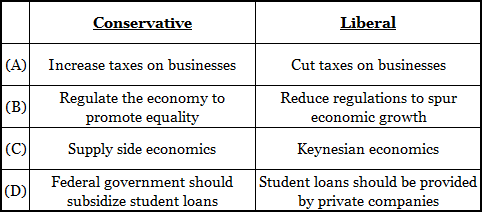
A | |
B | |
C | |
D |
Question 18 Explanation:
The correct answer is (C). Supply-side economic theory holds that the best way to improve economic growth is by lowering taxes and decreasing regulation. Consumers then benefit from a greater supply of goods and services at lower prices, and employment increases. This fits in with conservative beliefs in lower taxes and less regulation.
Keynesian economics is a demand-side theory. It states that the most important driving force in the economy is the aggregate demand created by households, businesses, and the government. During economic downturns, Keynesian policies favor deficit spending by the government in order to stimulate aggregate demand and spur economic growth. This fits in with liberal support for a greater government role in the economy.
Keynesian economics is a demand-side theory. It states that the most important driving force in the economy is the aggregate demand created by households, businesses, and the government. During economic downturns, Keynesian policies favor deficit spending by the government in order to stimulate aggregate demand and spur economic growth. This fits in with liberal support for a greater government role in the economy.
Question 19 |
Which of the following polls is considered most reliable on election day?
Benchmark polls | |
Entrance polls | |
Exit polls | |
Tracking polls |
Question 19 Explanation:
The correct answer is (C). Exit polls are most reliable because voters are asked who they voted for immediately after they leave the polling place.
Entrance polls (B) are less reliable than exit polls because some people change their minds once they are inside the polling place. Benchmark polls (A) and tracking polls (D) are the same thing, so neither can be correct. That type of poll occurs frequently throughout an election season and shows who has the most support prior to election day.
Entrance polls (B) are less reliable than exit polls because some people change their minds once they are inside the polling place. Benchmark polls (A) and tracking polls (D) are the same thing, so neither can be correct. That type of poll occurs frequently throughout an election season and shows who has the most support prior to election day.
Question 20 |
Which of the following controls American monetary policy?
Congress | |
The Department of the Treasury | |
The Federal Reserve Board | |
The Office of Management and Budget |
Question 20 Explanation:
The correct answer is (C). The Federal Reserve Board controls monetary policy, which involves interest rates and the size of the money supply.
Congress (A) sets fiscal policy through the federal budget. The Treasury Department (B) and the Office of Management and Budget (D) make fiscal policy recommendations to the President of the United States.
Congress (A) sets fiscal policy through the federal budget. The Treasury Department (B) and the Office of Management and Budget (D) make fiscal policy recommendations to the President of the United States.
Question 21 |
Questions 21–22 refer to the table below. The data is from a poll conducted in 2016. Respondents were read the following statement: “In the next decade, a political revolution might be necessary to redistribute money from the wealthiest Americans to the middle class.”
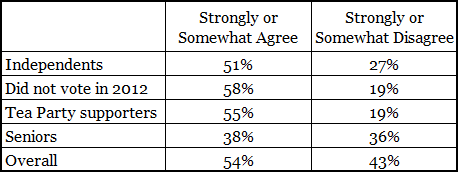
Assuming the data above were derived from a properly administered scientific poll, which of the following is true?
Most Americans did not vote in 2012 | |
Independents were neutral or unsure 22 percent of the time | |
Seniors are the only group that disagreed with the statement | |
The average American was more likely than a Tea Party supporter if they agreed with the statement |
Question 21 Explanation:
The correct answer is (B). Independents expressed an opinion 78 percent of the time, which means they were either neutral or unsure 22 percent of the time.
There is no way of knowing how many Americans voted based on the data in the table, so answer (A) is incorrect. Slightly more seniors agreed than disagreed with the statement, which eliminates answer (C). Tea Partiers agreed with the statement 55 percent of the time, compared to the 54 percent average, so answer (D) is also incorrect.
There is no way of knowing how many Americans voted based on the data in the table, so answer (A) is incorrect. Slightly more seniors agreed than disagreed with the statement, which eliminates answer (C). Tea Partiers agreed with the statement 55 percent of the time, compared to the 54 percent average, so answer (D) is also incorrect.
Question 22 |
The data is from a poll conducted in 2016. Respondents were read the following statement: “In the next decade, a political revolution might be necessary to redistribute money from the wealthiest Americans to the middle class.”

In what way does this data illustrate that respondents might be misinformed about redistribution of wealth?
Independents do not usually have an opinion on most issues | |
People who do not vote do not usually participate in public opinion polls | |
Tea Party supporters do not support tax increases that would be required to redistribute wealth | |
Other public opinion polls show that seniors are overwhelmingly in favor of redistribution of wealth |
Question 22 Explanation:
The correct answer is (C). Tea Partiers want less government involvement in Americans lives; they want to reduce taxes. A political revolution to redistribute wealth would mean the government would either confiscate property or greatly increase taxes, both of which the Tea Party is against. Therefore, the Tea Party respondents must be misinformed on this issue.
Independents often have opinions on issues; they just do not identify with either major party. Therefore, answer (A) may be eliminated. Many nonvoters may participate in the public opinion polls, so answer (B) may also be eliminated. Answer (D) is plausible but does not directly address the question.
Independents often have opinions on issues; they just do not identify with either major party. Therefore, answer (A) may be eliminated. Many nonvoters may participate in the public opinion polls, so answer (B) may also be eliminated. Answer (D) is plausible but does not directly address the question.
Question 23 |
Public opinion research shows that broad beliefs, such as what a person wants from government,
Form early in life | |
Are typically unstable throughout life | |
Are difficult for researchers to measure, so little is known about them | |
Are influenced most by media outlets |
Question 23 Explanation:
The correct answer is (A). The earliest agents of socialization immediately create a value system in each person. These values often are stable throughout a person’s life (B) and are easy to identify and measure (C). While media is an agent of socialization, it is not as strong as family (D).
Question 24 |
As more immigrants from Islamic nations become citizens, which of the following is the most likely scenario?
Republican voters begin to desire a decrease in foreign aid to Israel | |
Older voters begin to turn toward the Republican Party | |
Intraparty differences develop within the Democratic Party | |
Republican voters support higher tariffs on Islamic nations |
Question 24 Explanation:
The correct answer is (C). Traditionally, voters of the Jewish faith vote Democratic. Immigrants identifying as members of the Islamic faith are typically aligned with the Democratic Party. As the latter group grows in numbers, policy differences within the Democratic Party over foreign relations with Israel will become more evident.
Question 25 |
An issue’s importance to a person is referred to as
Civic skills | |
The halo effect | |
Salience | |
Liberalization |
Question 25 Explanation:
The correct answer is (C). The word "salience" is used in political science to designate the importance of issues, particularly for voters.
Once you are finished, click the button below. Any items you have not completed will be marked incorrect.
There are 25 questions to complete.
|
List |
Next Practice Test:
Unit 5: Political Participation >>
AP US Government Main Menu >>
